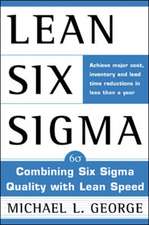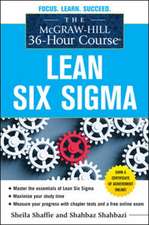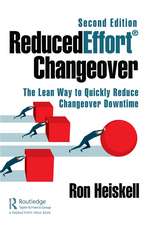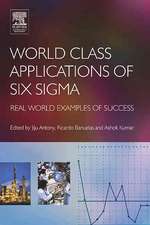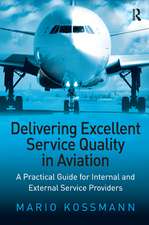The Lean Six Sigma Guide to Doing More With Less – Cut Costs Reduce Waste and Lower Your Overhead
Autor MO Georgeen Limba Engleză Hardback – 18 feb 2010
These days, enterprises need to reduce operating costs as quickly as possible without compromising quality and customer service levels. In the last ten years, business leaders have recognized Lean Six Sigma as one of the most valuable methodologies for realizing this goal.
The Lean Six Sigma Guide to Doing More With Less is your complete guide for taking advantage of Lean Six Sigma and related approaches to improve bottom line performance and enable competitive advantage. With focus and precision, this essential resource hones in on how to reduce overall costs by eliminating waste and providing competitive advantage through enterprise speed.
- In today′s recessionary environment Lean Six Sigma is a powerful and practical method to enable rapid and sustainable cost reduction through process improvement, enterprise speed and agility.
- Through the discussion of critical tools, case studies and implementation tips the guide provides a thorough and pragmatic understanding of how Lean Six Sigma can reduce cost. It provides instruction and insights for stand alone cost–out projects, the design and launch of enterprise initiatives and how to extract greater performance from legacy Six Sigma programs.
- Authored by Mark O. George, a Managing Director of Accenture′s Process & Innovation Performance service line, which is largely based on the expertise of the former George Group, acquired by Accenture in 2007.
Preț: 203.47 lei
Nou
38.95€ • 42.32$ • 32.74£
Carte disponibilă
Livrare economică 31 martie-14 aprilie
Specificații
ISBN-10: 0470539577
Pagini: 352
Ilustrații: Illustrations
Dimensiuni: 152 x 229 x 20 mm
Greutate: 0.54 kg
Editura: Wiley
Locul publicării:Hoboken, United States
Public țintă
Managers, executives and businesspeople who want to reduce costs in the least amount of time possibleDescriere
Praise for The Lean Six Sigma guide to Doing More with Less"At Frito Lay, we have applied many of the concepts and tools in this book, and we are realizing a five to seven times return on our annual Lean Six Sigma investment."
Tony Mattei, Lean Six Sigma Director, Frito Lay
"Ecolab has experienced a sustainable, competitive advantage through Lean Six Sigma. The principles in this book are helping us drive greater value for our share–holders, better service for our customers, and talent development opportunities for our associates."
Jeffrey E. Burt, Vice President and Global Deployment Leader, Lean Six Sigma, Ecolab
"This book gives excellent insights into Lean Six Sigma and its strong impact within different industries. We used Lean Six Sigma in numerous process improvement projects, which, in turn, helped to create momentum and set up a process improvement culture. Amid a challenging economic environment, we are accelerating this initiative globally."
Satheesh Mahadevan, Directeur des Processus, Société Générale
"Our Lean Six Sigma deployment of the concepts and tools described in this book is transforming our business with tangible benefits for our employees, customers, suppliers, and shareholders."
Jeffrey Herzfeld, Sr. Vice President and General Manager, Teva Pharmaceuticals USA
"We have deployed the holistic Lean Six Sigma strategy described by Mark George across our enterprise. It is providing remarkable returns for Unum."
Bob Best, Chief Operating Officer, Unum
"The Lean Six Sigma Guide to Doing More with Less presents a comprehensive view of operations transformation, the approaches required for success, leadership′s role, and the competitive advantage that results. Transformational changes are enabling us to do more with less, by investing and working smarter."
Ted Doheny, President and COO, Joy Mining Machinery
Textul de pe ultima copertă
Praise for The Lean Six Sigma guide to Doing More with Less"At Frito Lay, we have applied many of the concepts and tools in this book, and we are realizing a five to seven times return on our annual Lean Six Sigma investment."
Tony Mattei, Lean Six Sigma Director, Frito Lay
"Ecolab has experienced a sustainable, competitive advantage through Lean Six Sigma. The principles in this book are helping us drive greater value for our share–holders, better service for our customers, and talent development opportunities for our associates."
Jeffrey E. Burt, Vice President and Global Deployment Leader, Lean Six Sigma, Ecolab
"This book gives excellent insights into Lean Six Sigma and its strong impact within different industries. We used Lean Six Sigma in numerous process improvement projects, which, in turn, helped to create momentum and set up a process improvement culture. Amid a challenging economic environment, we are accelerating this initiative globally."
Satheesh Mahadevan, Directeur des Processus, Société Générale
"Our Lean Six Sigma deployment of the concepts and tools described in this book is transforming our business with tangible benefits for our employees, customers, suppliers, and shareholders."
Jeffrey Herzfeld, Sr. Vice President and General Manager, Teva Pharmaceuticals USA
"We have deployed the holistic Lean Six Sigma strategy described by Mark George across our enterprise. It is providing remarkable returns for Unum."
Bob Best, Chief Operating Officer, Unum
"The Lean Six Sigma Guide to Doing More with Less presents a comprehensive view of operations transformation, the approaches required for success, leadership′s role, and the competitive advantage that results. Transformational changes are enabling us to do more with less, by investing and working smarter."
Ted Doheny, President and COO, Joy Mining Machinery
Cuprins
Foreword.Preface.
Acknowledgments.
Chapter 1 Why Use Lean Six Sigma to Reduce Cost?
Transactional Example: Lean Six Sigma Transforming Our Government.
The Alloy of High Performance: Why Choose Lean Six Sigma to Reduce Cost?
Lean Six Sigma versus Traditional Cost–Cutting Tactics.
Emerging Stronger Than Ever.
Spotlight #1.
How to Use This Book.
Overview of Part I: Process Cost Reduction a Focus on the Tools of Waste Elimination.
Overview of Part II: Enterprise Cost Reduction a Focus on Value, Speed, Agility and Competitive Advantage.
Overview of Part III: Accelerating Deployment Returns Getting More, Faster, from a Lean Six Sigma Deployment.
Part I Process Cost Reduction: A Focus on Waste Elimination.
Introduction to Part 1.
Chapter 2 Find Cost Reduction Opportunities in Waste.
The Seven Common Faces of Waste: TIMWOOD.
Using the Full LSS Toolkit to Drive Cost Reduction.
Spotlight #2.
Special Tips for Nonmanufacturing Processes.
Key Success Factors in Reducing Costs in Services and Retail.
Spotlight #3.
Design a Successful Lean Six Sigma Project or Pilot.
Which Methodology Is Right for Your Project?
Identifying the Players and Their Roles.
Chapter 3 Use the Voice of the Customer to Identify Cost–Cutting Opportunities.
Customer Types and Their Needs.
Collecting Data on Customer Needs.
Getting Specific about Customer Needs.
Avoiding Misinterpretations.
Conclusion.
Chapter 4 Make Processes Transparent to Expose Waste.
How to Define the Boundaries through SIPOC Diagrams.
Using Value Stream Maps to Achieve Transparency.
Conclusion.
Chapter 5 Measure Process Efficiency: Finding the Levers of Waste Reduction.
Process Cycle Efficiency (PCE): The Key Metric of Process Time and Process Cost.
Little s Law: Understanding the Levers for Improving Process Speed.
The WIP Cap Method: How Limiting WIP Can Increase Process Speed and Reduce Costs.
Using PCE and Little s Law to Drive Cost Reduction.
Chapter 6 Improve Your Analysis Skills: How Understanding Variation, Root Causes, and Factor Relationships Can Help You Cut Costs While Improving Quality.
Analysis Skill #1: Learning to Read Variation.
Analysis Skill #2: Digging Out Root Causes.
Analysis Skill #3: Establishing relationships between factors.
Conclusion.
Chapter 7 Make Rapid Improvements through Kaizens.
Quick Overview: The Kaizen Approach.
When Should You Use Kaizens in Cost Reduction Projects.
Seven Keys to Kaizen Success.
Conclusion.
Part II Raising the Stakes: Reducing Costs at an Enterprise Level.
Chapter 8 Think Transformation, Not Just Improvement.
Attain a Proper Understanding of the Extent of the Opportunity.
Consciously Choose a Path to Capture the Opportunity.
Plan for a Transformation Journey.
Leadership Challenges in Leading a Transformation.
Conclusion.
Spotlight #4.
Transformation at Owens–Illinois.
Chapter 9 Unlock the Secrets to Speed and Flexibility.
Alignment and Analytics.
A Model of Speed and Agility.
Economic Order Quantity (EOQ) The First 100 Years.
Augmenting EOQ with Lean Analytics.
The Equations in Action.
Conclusion.
Chapter 10 Reduce the Cost of Complexity.
The Hidden Cost of Added Offerings on Processes.
Assessing Complexity in Your Business: A Holistic View.
Highlights of the Complexity Analysis Process.
Complexity Reduction as the Gateway to Transformation.
Conclusion.
Chapter 11 Look Outside Your Four Walls to Lower Costs Inside.
What Is an Extended Enterprise?
Working on the Supplier End of the Extended Enterprise.
What to Do When You re the Supplier: Extending Your Enterprise Downstream.
Conclusion.
Part III Speeding Up Deployment Returns: Strategies for Getting More, Faster, from a Lean Six Sigma Deployment.
Chapter 12 Create a Pipeline of Cost Improvement Projects: The Secret to Protecting the Heart of Your Business.
Developing Rigor in Project Identification and Selection.
From First–Time to All the Time: Shifting from a One–Time Event to an Ongoing System of Pipeline Management.
Conclusion: Maintaining a Dynamic Pipeline.
Spotlight #5.
Link Projects to Value Drivers.
Option 1: Value Driver Trees.
Option 2: Financial Analysis Decision Tree.
Option 3: Economic Profit.
Option 4: EP Sensitivity Analyses.
Value Driver Example.
Chapter 13 Smooth the Path through Change.
Change Readiness Assessments.
Leading versus Managing the Change.
Upgrading Your Communication Plan.
Process Ownership and Cost Accountability.
Conclusion: Restoring Faith, Hope, and Belief.
Chapter 14 Establishing a Center of Excellence.
What Is a CoE and What Does It Do?
Focus #1: Performance Management.
Focus #2: Replication: Copy and Paste Your Cost Savings.
How Can a CoE Fit into an Organization?
Weaving the CoE into Strategic Planning.
Conclusion.
Chapter 15 Gaining New Perspectives on Deployment Cost and Speed Opportunities.
Looking for Focus and Flexibility in Deployment.
Focusing Deployments on Business Issues.
Flexibility in Building Skills.
Conclusion.
Chapter 16 Reenergizing a Legacy Program.
Why Deployments Lose Steam.
Building a Steam Engine: Performance Management.
Process Ownership: The Partner of Performance Management.
How to Reenergize a Deployment.
Conclusion.
Index.
Notă biografică
Mark O. George is a Senior Executive at Accenture and is the Global Offering Group leader for Operations Consulting in the Process and Innovation Performance service line. Mark has designed and supported dozens of enterprise transformation initiatives for Fortune 500 and 1000 companies that have delivered hundreds of millions in economic profit. Accenture is a global management consulting, technology services, and outsourcing company with more than 186,000 people serving clients in over 120 countries, the company generated net revenues of $23.39 billion for the fiscal year ended August 31, 2008. Its home page is www.accenture.com.

